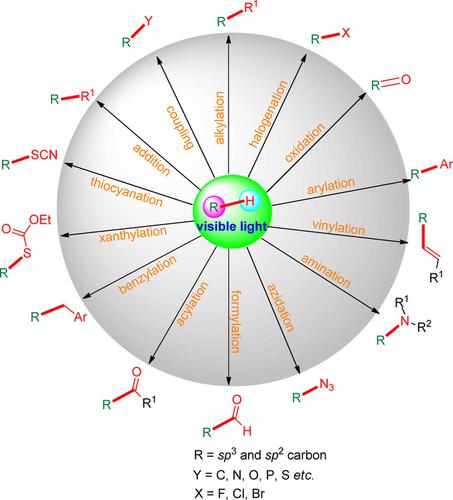当前位置:
X-MOL 学术
›
Adv. Synth. Catal.
›
论文详情
Our official English website, www.x-mol.net, welcomes your
feedback! (Note: you will need to create a separate account there.)
Visible Light‐Induced C−H Bond Functionalization: A Critical Review
Advanced Synthesis & Catalysis ( IF 4.4 ) Pub Date : 2018-10-18 , DOI: 10.1002/adsc.201800736 Lekkala Revathi 1 , Lekkala Ravindar 1 , Wan-Yin Fang 1 , K. P. Rakesh 1 , Hua-Li Qin 1
Advanced Synthesis & Catalysis ( IF 4.4 ) Pub Date : 2018-10-18 , DOI: 10.1002/adsc.201800736 Lekkala Revathi 1 , Lekkala Ravindar 1 , Wan-Yin Fang 1 , K. P. Rakesh 1 , Hua-Li Qin 1
Affiliation

|
In recent years, visible‐light‐induced C−H bond functionalization has become an emerging field at the forefront of organic chemistry. In a general sense, these approaches rely on the capability of metal complexes and organic dyes to convert visible light into chemical energy by engaging in single‐electron transfer with organic substrates, thus generating reactive intermediates. This review covers most of the strategies involving visible light‐induced benzylic and non‐benzylic alkylation, halogination, oxidation, vinylation, arylation, benzylation, acetylation, formylation, thiocyanation, xanthylation, azidation, amination, addition, and coupling reactions of sp2 and sp3 C−H bonds.
中文翻译:

可见光诱导的CH键功能化:关键评论
近年来,可见光诱导的CH键功能化已成为有机化学领域的新兴领域。从一般意义上讲,这些方法依赖于金属络合物和有机染料通过与有机底物进行单电子转移将可见光转化为化学能的能力,从而生成反应性中间体。这篇综述盖涉及可见光诱导苄和非苄型烷基化,halogination,氧化,乙烯化,芳基化,苄基化,乙酰化,甲酰化,硫氰化,xanthylation,叠氮化,胺化,此外,与偶联的反应中的策略的最SP 2和sp 3 CH键。
更新日期:2018-10-18
中文翻译:

可见光诱导的CH键功能化:关键评论
近年来,可见光诱导的CH键功能化已成为有机化学领域的新兴领域。从一般意义上讲,这些方法依赖于金属络合物和有机染料通过与有机底物进行单电子转移将可见光转化为化学能的能力,从而生成反应性中间体。这篇综述盖涉及可见光诱导苄和非苄型烷基化,halogination,氧化,乙烯化,芳基化,苄基化,乙酰化,甲酰化,硫氰化,xanthylation,叠氮化,胺化,此外,与偶联的反应中的策略的最SP 2和sp 3 CH键。











































 京公网安备 11010802027423号
京公网安备 11010802027423号